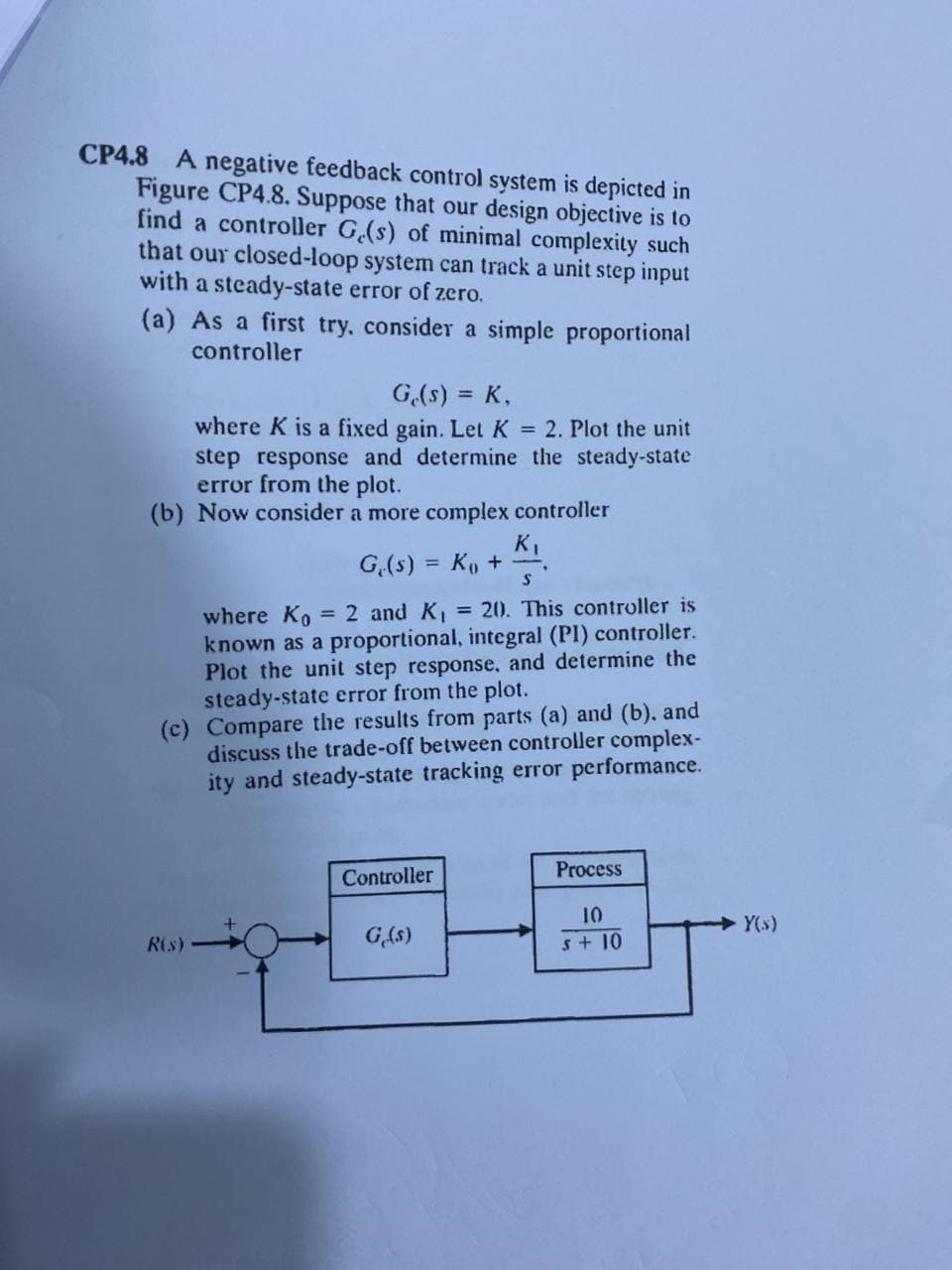CP4.8 A negative feedback control system is depicted in Figure CP4.8. Suppose that our design objective is to find a controller G.(s) of minimal complexity such that our closed-loop system can track a unit step input with a steady-state error of zero. (a) As a first try, consider a simple proportional controller G,(s) = K, %3D
CP4.8 A negative feedback control system is depicted in Figure CP4.8. Suppose that our design objective is to find a controller G.(s) of minimal complexity such that our closed-loop system can track a unit step input with a steady-state error of zero. (a) As a first try, consider a simple proportional controller G,(s) = K, %3D
Introductory Circuit Analysis (13th Edition)
13th Edition
ISBN:9780133923605
Author:Robert L. Boylestad
Publisher:Robert L. Boylestad
Chapter1: Introduction
Section: Chapter Questions
Problem 1P: Visit your local library (at school or home) and describe the extent to which it provides literature...
Related questions
Question

Transcribed Image Text:CP4.8 A negative feedback control system is depicted in
Figure CP4.8. Suppose that our design objective is to
find a controller G.(s) of minimal complexity such
that our closed-loop system can track a unit step input
with a steady-state error of zero.
(a) As a first try, consider a simple proportional
controller
G,(s) = K,
%3D
where K is a fixed gain. Let K = 2. Plot the unit
step response and determine the steady-state
error from the plot.
(b) Now consider a more complex controller
K,
G.(s) = K, +
%3D
= 2 and K1 = 20. This controller is
where Ko
known as a proportional, integral (PI) controller.
Plot the unit step response, and determine the
steady-state error from the plot.
(c) Compare the results from parts (a) and (b), and
discuss the trade-off between controller complex-
ity and steady-state tracking error performance.
Process
Controller
10
s+ 10
Y(s)
R(s)
G(s)
Expert Solution
This question has been solved!
Explore an expertly crafted, step-by-step solution for a thorough understanding of key concepts.
This is a popular solution!
Trending now
This is a popular solution!
Step by step
Solved in 2 steps with 3 images

Knowledge Booster
Learn more about
Need a deep-dive on the concept behind this application? Look no further. Learn more about this topic, electrical-engineering and related others by exploring similar questions and additional content below.Recommended textbooks for you

Introductory Circuit Analysis (13th Edition)
Electrical Engineering
ISBN:
9780133923605
Author:
Robert L. Boylestad
Publisher:
PEARSON

Delmar's Standard Textbook Of Electricity
Electrical Engineering
ISBN:
9781337900348
Author:
Stephen L. Herman
Publisher:
Cengage Learning

Programmable Logic Controllers
Electrical Engineering
ISBN:
9780073373843
Author:
Frank D. Petruzella
Publisher:
McGraw-Hill Education

Introductory Circuit Analysis (13th Edition)
Electrical Engineering
ISBN:
9780133923605
Author:
Robert L. Boylestad
Publisher:
PEARSON

Delmar's Standard Textbook Of Electricity
Electrical Engineering
ISBN:
9781337900348
Author:
Stephen L. Herman
Publisher:
Cengage Learning

Programmable Logic Controllers
Electrical Engineering
ISBN:
9780073373843
Author:
Frank D. Petruzella
Publisher:
McGraw-Hill Education

Fundamentals of Electric Circuits
Electrical Engineering
ISBN:
9780078028229
Author:
Charles K Alexander, Matthew Sadiku
Publisher:
McGraw-Hill Education

Electric Circuits. (11th Edition)
Electrical Engineering
ISBN:
9780134746968
Author:
James W. Nilsson, Susan Riedel
Publisher:
PEARSON

Engineering Electromagnetics
Electrical Engineering
ISBN:
9780078028151
Author:
Hayt, William H. (william Hart), Jr, BUCK, John A.
Publisher:
Mcgraw-hill Education,